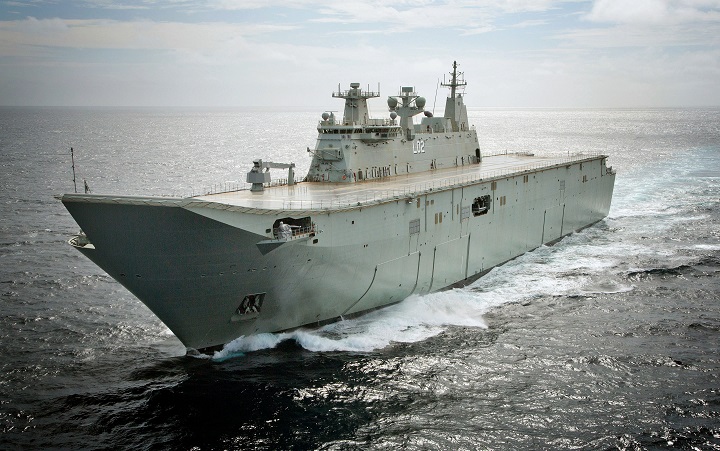 Today’s a great day for the Royal Australian Navy and the Australian Defence Force. It marks the commissioning of that $1.5 billion, 27,800-tonne behemoth soon to be known as HMAS Canberra. But as much as I hate to rain on this parade, Australia is still some time and many tough decisions away from true amphibious warfare capability. The ship is just a ‘host’ that enables the capability. Political and military leaders will need to take a two-year appetite suppressant to consider organisational changes and the purchase of additional equipment. When the party on Garden Island ends tonight, the real work continues.
Today’s a great day for the Royal Australian Navy and the Australian Defence Force. It marks the commissioning of that $1.5 billion, 27,800-tonne behemoth soon to be known as HMAS Canberra. But as much as I hate to rain on this parade, Australia is still some time and many tough decisions away from true amphibious warfare capability. The ship is just a ‘host’ that enables the capability. Political and military leaders will need to take a two-year appetite suppressant to consider organisational changes and the purchase of additional equipment. When the party on Garden Island ends tonight, the real work continues.
The ADF’s stated goal is to have an Amphibious Ready Group (ARG) capability by 2017. That might sound like plenty of time. But amphibious operations involve a complex and dangerous choreography and the seamless integration of joint military services. World-class amphibious players develop over decades. The US, UK, France and others have joint organisations consisting of service units dedicated solely to this kind of operation and have built an organisational culture around them. Amphibious warfare is a truly joint enterprise, requiring diligent and detailed integration of the three services.
The ADF is driven by the individual services and lacks the organisational mechanisms and culture for joint capability development. It will have to overcome those internal obstacles to get from naming a really big boat to conducting amphibious manoeuvres under non-permissive conditions. Here are a few issues to be addressed.
The LHD is a helicopter-centric ship. Its flight deck is big, but its dock is small compared to US or UK amphibious ships, and it will normally carry only four small landing craft. But the landing-force order of battle is vehicle-centric. Will the Land 400 program include the purchase of vehicles that can swim or that are light enough to be lifted by helicopters in order to relieve strain on the ship’s limited landing craft?
The current landing-force vehicles weren’t designed for wading and can tolerate only about two feet of water. That could be ameliorated by a beach recovery-vehicle to drag drowned vehicles ashore and push off stuck landing craft but the ADF hasn’t got any of those. A large hovercraft could potentially eliminate the problem altogether but Canberra’s dock is the wrong type for those.
If Australia is to achieve its stated capability goals, it’ll need to have someone with sufficient authority to champion the cause when it clashes with perceived single-service interests. At present, the Joint Capability Authority has a coordinating role only and actually doesn’t manage any capabilities or major procurement programs.
Then there are helicopters. HMAS Canberra is apparently capable of holding 18 helicopters (depending on the type of helicopter). Unfortunately, it’s not as simple as placing a helicopter on a ship. Twenty years ago, the US Army found that out the hard way when it placed helicopters on two US aircraft carriers for Operation Uphold Democracy in Haiti. Most of those helicopters had to be junked after the operation because they weren’t properly ‘marinised’.
Of course, there are degrees of marinisation. While there has been much criticism of the Army’s MRH-90 model helicopters, those aircraft were chosen largely because they were deemed to be better for amphibious operations. Key features like their composite frame (which doesn’t corrode) and blade brakes make them more conducive to operations at sea. But an ANAO audit recently noted that the MRH90 aircraft ‘has metal parts that corrode, ranging from rivets in the tail assembly to complex assemblies in the landing gear, engine and transmission’. Additionally, the aircraft lacks automatically-collapsible blades, making flight deck evolutions slower and inherently more dangerous, potentially halving the force projection rate. The ARH-90 wasn’t designed to go to sea and will present all these problems plus some more of its own.
Finally, there’ll be support force and enabler issues. The ADF has already dedicated 2 RAR as its amphibious infantry force. But deep amphibious expertise is needed in supporting arms and services, notably intelligence, logistics, aviation, and engineering. The present intent is to draw those from non-specialist brigades as required. The current Plan ‘Beersheba’ will see them rotate out of that role every year (say it isn’t so).
These issues aren’t showstoppers, but coming up with solutions, techniques, and procedures to mitigate them inside two years will require an intense effort. It means prioritising resources and training and that will inevitably have impacts elsewhere. Whether the individual services are willing to accept those impacts will be the true test of whether the ADF is serious about its amphibious capability.
Yes, the boat is impressive. But it’ll be the teamwork, sacrifice, and leadership needed to build a real amphibious capability that will truly impress. If Australia’s leaders try to use this capability before it’s properly prepared, the results will be disappointing. Fixing some organisational deficiencies and giving more attention to the capability associated with this project will help.
Lieutenant Colonel Jan K. Gleiman is an active duty US Army officer and a visiting fellow at ASPI from United States Pacific Command. These are his personal views. Image courtesy of Department of Defence.

